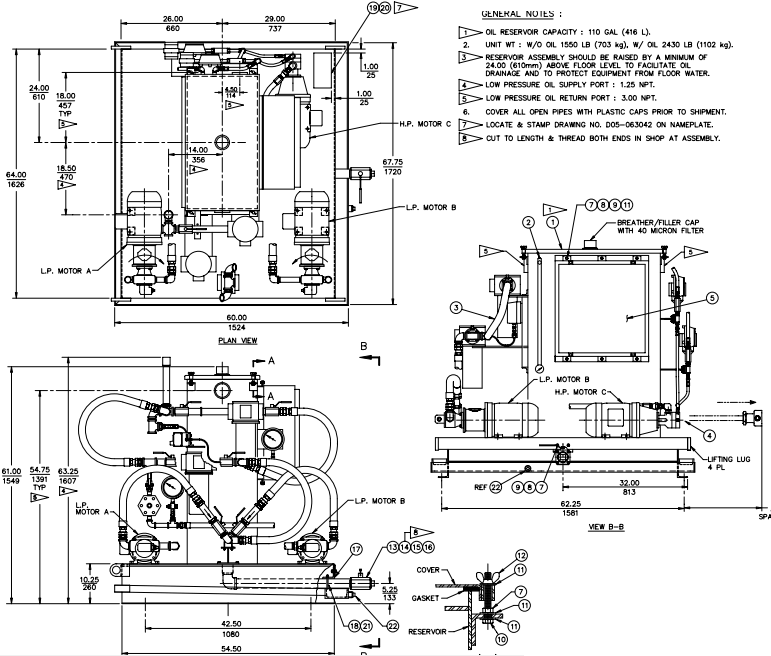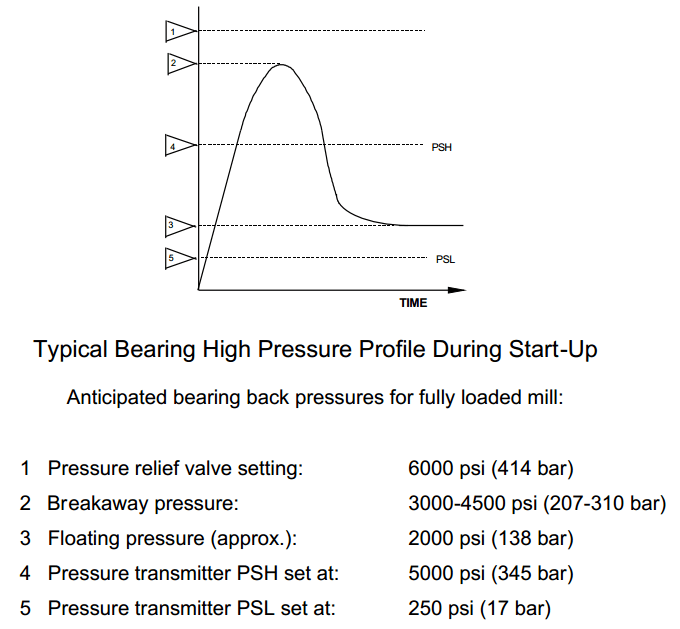On a 11’-6” x 22’-0” Ball Mill, the trunnion bearing lubrication system provides continuous low pressure flood oil for cooling and lubrication of the bearings, and high pressure oil for hydrostatic lift of the feed and discharge trunnions during start-up of the mill. System monitors including pressure switches and flow monitors are provided, along with temperature sensors that monitor the condition of the lube system. The signals from any of these monitors will alarm or trip the system depending on the deviation from the operating parameters.

The ball mill’s low pressure oil system pumps oil from the reservoir through a filter assembly to clean the oil before the flow is sent to the trunnion bearings.
During start-up, the oil is also pumped to the high pressure pump. Dual cartridge filters, connected in parallel, continually clean the oil. The duplex configuration of the filters allows for uninterrupted operation of the mill during filter cartridge replacement and maintenance. Flow monitors in the trunnion bearing supply lines monitor oil flow to the bearings and will alarm and trip the mill is low flow is indicated.
The ball mill’s high pressure oil system is designed to lift the trunnions during start-up by supplying high pressure oil. The high pressure pump is programmed to shut-down after the mill has been running for a predetermined amount of time. The high pressure pump pumps oil through the high pressure supply lines to the trunnion bearings. Pressure transmitters in the high pressure oil supply lines monitor the supply of oil to the bearings and provide interlock signals for mill operation to the control system.
The breakaway pressure is influenced by the amount of residual oil present in the trunnion bearings. Pressure can vary by as much as 3000 psi (207 bar) between a dry bearing and a bearing that had just operated. Start-up may have to be delayed to allow the weight of the mill to squeeze out excessive oil and achieve enough back pressure to satisfy the PSH. PSH setpoint must be set between breakaway pressure and floating pressure.
The trunnion bearings have temperature sensor assemblies to monitor the operating temperature of the trunnions. The readings of the temperature sensors are sent to the control system where they are monitored automatically. If the operating temperature exceeds the programmed alarm and trip levels, the mill will be shutdown automatically. It is difficult to predict the exact operating temperature of trunnion bearings.
Experience has shown that each bearing stabilizes to its own temperature, ranging between 90°F(32°C) and 125°F(52°C). Many factors, such as ambient temperature, quantity of oil, viscosity, bearing clearance, alignment, etc., contribute to the final operating temperature. If bearing temperatures do not stabilize after 5 hours of operation within this parameter, the mill must be shut down and corrective action taken.
The instrumentation must be calibrated before starting the mill. The easiest and safest way to adjust the instrumentation is to very carefully monitor all bearing temperatures during start-up and under normal grinding conditions. Adjust the individual set points for each bearing 10°F(5.5°C) higher than the stabilized temperature for “alarm”, and 15°F(8°C) for “shut down”.
A surface temperature of 122°F(50°C) is about the hottest a person can hold his hand against without discomfort.
Maintaining the ball mill charge and monitoring the feed rate will help to ensure maximum efficiency of the grinding system. System interlocks monitor the operating condition of the grinding mill and will shut down the mill if conditions deviate from operating parameters. Regular monitoring of the feed rate, ore hardness, mill power draw, mill charge volumes (charge weights), and periodic visual checks of the ball volume (with the charge ground out of the mill and the mill stopped) will give the trends of ball consumption per ton of material ground. With the information gathered per the above, a schedule of ball charge addition (quantity and intervals) can be established and maintained.
